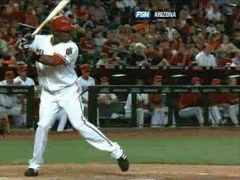quote:
Originally posted by Quincy:
Ah, the 'torque' issue again.
If 'torque' is an external force moving to center, and the pelvis is the center, then there actually is a degree of torque exerted by the bat head on the pelvis in the swing.
The pelvis, being the center, cannot exert external force on itself to center.
Since you need a dose of physics
In general, a particle (the bat head in this case) moving in a circle experiences both angular acceleration and centripetal acceleration.
http://theory.uwinnipeg.ca/physics/circ/node6.htmlStrong forearms in conjunction with strong triceps would indeed increase one's ability to propel the bat head in the swing.
I believe the topic was torque, correct?
Now you need a biomechanics lesson I guess.
THE PELVIS IS NOT CENTER! The sacrum/spine is!
Force would transfer up the leg into the acetabulum of the pelvis. From there it would use the pelvic bones (Ala) as the lever arm applying torque to the sacrum.
Since there is rotation in the swing, there is torque, unless you are a wizard or something using magic.
This topic discussion can go nowhere though if you really believe the "bat" is generating the force on the spine. Once again, maybe we are using magic.
The only force the bat creates is when it hits the ball and when the player begins the load phase and torque is created between the top and bottom half. Call it torso-pelvic separation if you like. Either way, the bat did not start first. Its a dead piece of wood! All the clips prove this but you refuse to see it for some reason.
I really think you are just trying to ruffle feathers with this nonsense.
BTW, your comment on the strong hands is pure opinion that has been disproved in studies. Forearm strength plays no part in bat velocity.


